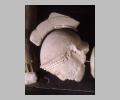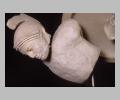
Aegina E 6, Dying Warrior in right corner of E. Ped. 2, right foot

Aegina E 6, Dying Warrior in right corner of E. Ped. 2, head, from below

Aegina E 6, Dying Warrior in right corner of E. Ped. 2, view facing pedime...

Aegina E 6, Dying Warrior in right corner of E. Ped. 2, left side of head

Aegina E 6, Dying Warrior in right corner of E. Ped. 2, right leg

Aegina E 6, Dying Warrior in right corner of E. Ped. 2, head and upper body
| Collection: | Munich, Glyptothek |
| Title: | Aegina, E. Ped. 2, fig. E 6: Dying Warrior in right corner |
| Context: | From Aegina, Sanctuary of Aphaia |
| Findspot: | Excavated at Aegina, Sanctuary of Aphaia |
| Summary: | Dying warrior with wound in right leg |
| Material: | Marble |
| Sculpture Type: | Architectural |
| Category: | Statuary group |
| Placement: | East pediment |
| Style: | Late Archaic |
| Technique: | In-the-round |
| Date: | ca. 490 BC - ca. 480 BC |
| Scale: | Life-size |
| Region: | Saronic Gulf |
| Period: | Late Archaic |
| In Group: | Aegina East Pediment 2 |
Subject Description:
The Dying Warrior in the right-hand corner is a victim of the archer across the gable. A hole in the upper right thigh held a metal arrow. The warrior has fallen to the ground and lies stretched on his right side, his shield behind him. His feet point into the corner, a reversal of the scheme in the West Pediment. The torso has survived in only fragmentary form, but apparently mirrored the figure in the opposite corner, with a different positioning of the arms. The right arm is restored as stretching along the edge of the pediment. The hand actually projects beyond the pediment, as does the right foot. The entire body appears close to rolling over the edge. Visually it is held back only by the weight of the shield behind the body; the left arm is caught in the shield-stay. In actuality the torso must have been doweled to the floor at the hip, like E11. This young, beardless warrior was without any armor excepting helmet, shield and weapon. The crest of the helmet, also of marble, was carved separately. When found the head had two tendrils of lead still in place, as recorded by Cockerell. Similar examples of tendrils were found in later excavations. The two tiers of holes surrounding the face indicate that all the hair was added. Ohly restores him with long tendrils as well, falling forward over each shoulder, though such a style is unusual and old-fashioned for the East Pediment.
Form & Style:
The Dying Warrior exhibits advanced stylistic development in several respects: the pose, particularly the way in which the figure projects beyond the front plane of the pediment; the head, with large features and unity of structure like that of Athena, with which it bears close similarity; the expression of pain. The face does not depict a grimace, a more obvious expression used sometimes in the archaic period, but rather shows the gradual loss of consciousness or control caused by the intensity of the pain. Both eyes have begun to close, the left noticeably moreso. The left arm has slipped through the shield-stay; the left hand is limp. The torso is about to drop; the head slumps to the chest. In the process of the fall the helmet has been knocked askew.
Condition: Fragmentary
Condition Description: Preserved: head, fragment of upper torso, left hand, legs
Material Description:
Parian Marble
Associated Building: Aegina, Temple of Aphaia